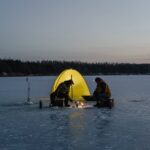Everywhere in the USA That Could See the Northern Lights This Week as Solar Event Is Confirmed

The night sky has always been a canvas of wonder—studded with stars, streaked by comets, and, for the lucky few, illuminated by the ethereal glow of the Northern Lights. Usually, witnessing the aurora borealis requires a journey to the Arctic Circle, where the sky comes alive in waves of green, purple, and red. But this week, something extraordinary is happening. The Northern Lights are breaking their usual boundaries, stretching across the United States in a rare celestial display.
This isn’t just a beautiful accident. It’s the result of an intense solar event—an outburst of energy from the Sun powerful enough to send charged particles racing toward Earth. When these particles collide with our planet’s magnetic field, they create an electric dance of light in the atmosphere. While auroras usually stay confined to high-latitude regions, strong solar storms push them farther south, making them visible to people who may have never seen them before.
Events like this don’t happen often. The last time a solar storm of this magnitude brought the aurora deep into the U.S., many were left in awe, standing beneath skies ablaze with colors they never imagined they’d witness in their lifetime. And now, that opportunity is here again. Whether you’re in the Midwest, the Northeast, or even parts of the South, there’s a chance you could look up and see the sky transformed into a living, breathing painting.
Why Are the Northern Lights Visible in More Places?
 Image source: Shutterstock
Image source: Shutterstock
What’s happening right now is a conversation between the Sun and the Earth. A powerful solar storm has sent a wave of charged particles racing toward our planet. When they collide with Earth’s magnetic field, they ignite the sky in shifting waves of green, red, and violet.
Most of the time, these lights stay locked in the far north—Alaska, Canada, Scandinavia. But sometimes, the Sun sends out something stronger, something capable of shaking up the rules.
At the heart of this phenomenon is a coronal mass ejection, or CME—a massive burst of energy from the Sun that hurls charged particles into space. When one of these waves is intense enough, it disturbs Earth’s magnetic shield, allowing the auroras to travel farther south than usual.
That’s exactly what’s happening now. Scientists at NOAA, the National Oceanic and Atmospheric Administration, have been tracking this latest solar storm. Their models predict that this surge of solar activity is powerful enough to push the Northern Lights into skies that rarely see them.
For millions of people who have never witnessed an aurora before, this could be their first chance.
Where in the U.S. Can You See the Northern Lights?
If you’ve ever dreamed of seeing the Northern Lights but figured you’d have to travel to the Arctic, this might be your moment. The aurora is stepping beyond its usual stage, and if the conditions are right, you could witness one of nature’s most breathtaking performances right in your own backyard.
The best places to see the aurora are where the night sky is darkest, away from city lights that drown out its glow. Right now, states in the Upper Midwest and Northern Plains—North Dakota, South Dakota, Minnesota, Wisconsin, and Michigan—are in prime position for a spectacular display. In these regions, vibrant streaks of green and red may stretch across the entire sky, rippling like waves of fire.
But they’re not the only ones in luck. The aurora may also extend into the Northeast and Pacific Northwest, bringing flashes of color to Maine, Vermont, New Hampshire, Montana, Idaho, and Washington. While these states aren’t strangers to celestial wonders, they don’t often get auroras strong enough to light up the sky with this level of intensity.
And then, there’s the wildcard factor. If this storm continues to grow in strength, the aurora could push even farther south—perhaps into places where it’s almost never seen. Residents in New York, Pennsylvania, Nebraska, Iowa, and Illinois might notice an eerie glow low on the northern horizon, like a distant fire burning in the atmosphere. Some reports even suggest that if conditions align perfectly, the glow could reach as far south as Missouri and Kentucky, where the Northern Lights are usually just a story in textbooks.
There’s no certainty, only possibility. But that’s what makes this moment so special. The rarest sights don’t come with guarantees—they come with a chance. And all you have to do is look up.
How to Give Yourself the Best Shot at Witnessing This Moment
 Image source: Shutterstock
Image source: Shutterstock
The Northern Lights don’t follow a schedule. They don’t wait for convenience. If you want to witness them, you have to be ready.
Here’s how to maximize your chances of seeing this rare display:
-
Find the darkest place possible: City lights will wash out the aurora, making it nearly impossible to see. Drive away from the glow of streetlights—state parks, open fields, and rural areas are your best bet. The darker your surroundings, the clearer the lights will be.
-
Look north: If you’re in a state where the aurora is pushing its limits, don’t expect it to be overhead. Instead, look toward the northern horizon, where you might catch shifting bands of green, red, or even purple light.
-
Check the forecast—both space and weather: Even the strongest aurora won’t be visible if the sky is covered in clouds. Use weather apps to track local conditions, and check NOAA’s aurora forecast or apps like “My Aurora Forecast” to see real-time geomagnetic activity in your area.
-
Be patient: The best viewing window is typically between 10 PM and 2 AM local time, when the sky is at its darkest. The aurora can flicker unpredictably—sometimes for hours, sometimes for just minutes—so be prepared to wait.
-
Let your eyes adjust: It takes at least 20-30 minutes for your eyes to fully adapt to the darkness. Avoid staring at your phone screen while you wait, as the artificial light will reset your night vision and make it harder to see faint auroras. If you need to check updates, use a red-light filter or dim your screen as much as possible.
-
Capture the moment—but don’t forget to live it: A camera with manual settings can capture the aurora better than the human eye, but don’t spend the entire time focused on taking pictures. Some moments aren’t meant to be stored in a gallery—they’re meant to be experienced.
Nature doesn’t send invitations. It just happens. And the ones who are prepared, the ones who step away from the noise and into the silence, will be the ones who see it.
Look Up Before the Moment Passes
Moments like this don’t happen often.
The last time a solar storm of this magnitude sent the Northern Lights deep into the United States, people stood outside in the cold, in the quiet, watching the sky come alive. Some captured the moment with their cameras, while others simply let their eyes absorb the beauty. Either way, they all left with a memory that stayed with them long after the lights faded.
Now, that moment is here again.
If you’re lucky enough to witness it, don’t take it for granted. This isn’t just a rare spectacle—it’s a reminder. A reminder that the most incredible things in life don’t always come with warnings or invitations. They don’t wait for perfect timing. They happen unexpectedly, in the stillness of the night, for those who take the time to notice.
Maybe this is nature’s way of telling us something. That wonder isn’t found in a screen, in a schedule, or in a plan—it’s found in the simple act of looking up.
Featured Image Source: Shutterstock
Loading...






